
Scaffold web spiders (Nesticidae) is a family of araneomorph spiders closely allied with tangle web spiders. Like the "Theridiidae", these spiders have a comb of serrated bristles on the hind tarsi that are used to pull silk bands from the spinnerets. It contains 16 genera and about 300 species, many of which are associated with caves or overhangs. The genus Nesticus is the type for the family and is found throughout the world. The related Eidmannella has speciated considerably in Texas caves and includes some extremely localized species that are considered threatened. One species, Eidmannella pallida, is found in caves and under overhangs, but also in agricultural fields and other habitats away from such restricted areas. The genus Carpathonesticus is found in central Eurasia.
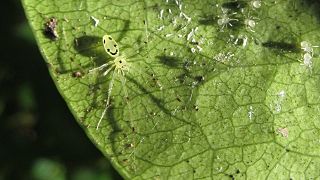
Theridion grallator, also known as the Hawaiian happy-face spider, is a spider in the family Theridiidae that resides on the Hawaiian Islands. T. grallator obtains its vernacular name of "Hawaiian happy-face spider" from the unique patterns superimposed on its abdomen, specifically those that resemble a human smiling face. T. grallator is particularly notable because of its wide range of polymorphisms that may be studied to allow a better understanding of evolutionary mechanisms. In addition to the variety of color polymorphisms present, T. grallator demonstrates the interesting quality of diet-induced color change, in which its appearance temporarily changes as it metabolizes various food items.

Oecobius navus is a small cosmopolitan cribellate spider species found across the world.
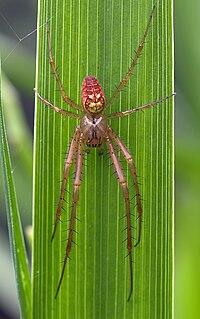
Metellina segmentata is a spider in the family Tetragnathidae with a Palaearctic distribution. This spiders name is often shortened to Meta segmentata, and some even call it Araneus segmentatus simply meaning, orb weaving spiders. It is primarily found in Europe, with the highest number in the United Kingdom, but the species has also been introduced to Canada.

Porrhothele antipodiana, the black tunnelweb spider, is a spider found throughout much of New Zealand and the Chatham Islands in bush and gardens and is one of New Zealand's most researched spiders. It is related to tarantulas, and is a harmless relative of the venomous Australian funnel-web spider.

Maevia inclemens or the Dimorphic Jumping Spider is a relatively common and colorful jumping spider of North America. In the males there are two forms, a very rare phenomenon in zoology. These use different courting displays, and differ in appearance: the "tufted" morph has a black body and pedipalps ("palps"), three black tufts across its "head", and pale legs; and the "gray" morph has black and white stripes all over its body and legs, orange palps, and no tufts. However, each form accounts for 50% of the adult males, and they are equally successful in mating. A female of Maevia inclemens is 6.5 to 8.0 millimetres long, while males are 4.75 to 6.50 millimetres long.

Rugathodes sexpunctatus is a minute species of spider in the family Theridiidae, the cobweb or tangle-web spiders. This family includes the medically important genus Latrodectus—the widow spiders. The species in the genus Rugathodes are too small to be dangerous to humans. Very little is known about most species in this genus.

Portia schultzi is a species of jumping spider which ranges from South Africa in the south to Kenya in the north, and also is found in West Africa and Madagascar. In this species, which is slightly smaller than some other species of the genus Portia, the bodies of females are 5 to 7 mm long, while those of males are 4 to 6 mm long. The carapaces of both sexes are orange-brown with dark brown mottling, and covered with dark brown and whitish hairs lying over the surface. Males have white tufts on their thoraces and a broad white band above the bases of the legs, and these features are less conspicuous in females. Both sexes have tufts of orange to dark orange above the eyes, which are fringed with pale orange hairs. Males' abdomens are yellow-orange to orange-brown with blackish mottling, and on the upper sides are black and light orange hairs, and nine white tufts. Those of females are pale yellow and have black markings with scattered white and orange-brown hairs on the upper side. P. schultzi has relatively longer legs than other Portia, and a "lolloping" gait.

Progradungula otwayensis, commonly known as the odd-clawed spider, is a species of cribellate spider endemic to the Great Otway National Park of Victoria, Australia. It is one of only two species in the gradungulid genus Progradungula.

Hyptiotes paradoxus, also known as the triangle spider, is a cribellate orbweaver in the family Uloboridae.
Anelosimus jabaquara is a species of spider found in subtropical, humid, lowland forests in Brazil. Anelosimus jabaquara was first described by Herbert W. Levi in 1956. These spiders cooperate to spin and repair the colonial web, capture prey, and care for the brood. Colony size is small, and the sex ratio is biased towards females.
Domitius menozzii is an araneomorph spider species of the family Nesticidae. It occurs in Italy, where it can be found in caves. It was described by Ludovico di Caporiacco in 1934.
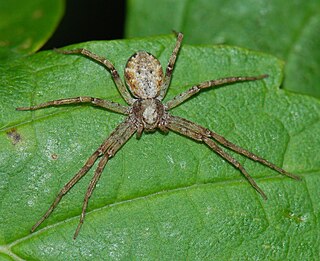
Philodromus cespitum is a species of running crab spider in the family Philodromidae. It is found in North America, Europe, North Africa, and parts of the Middle East and Asia. P. cespitum is a foliage-dweller, and is the most abundant species found in European fruit orchards. It acts as a biological control by preying on orchard pests. P. cespitum is a diurnal ambush hunter and preys on aphids, insects, and occasionally competitor spider species. Males court females by tapping on the females’ bodies with their forelegs. They then insert a genital plug into the female during copulation. Unlike in many other spider species, subsequent males can mate with plugged females by removing part of the plug prior to copulation. Males discriminate among females based on virginity and plug size, and can determine these factors using the females’ draglines and plug samples.
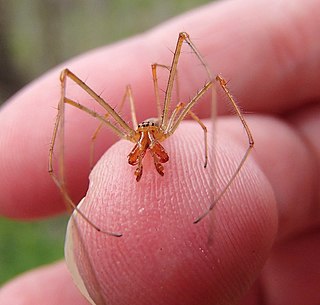
Tetragnatha versicolor is a species of long-jawed orb weaver in the spider family Tetragnathidae. It is found throughout North America, Canada, Central America, and Cuba, but are most common in the United States. T. versicolor is heavily concentrated in New England and the west coast in states like California and Washington. T. versicolor is considered a habitat generalist, and can thrive in many different environments. While they can be found in places like Grasslands, Wetlands, Forests, etc., they prefer dryer areas like normal trees and shrubs. Unlike other spiders in the genus Tetragnatha, T. versicolor will rarely reside near aquatic environments. T. versicolor will typically be colored dark yellow or pale orange and average around 5 mm for males and 6.5 mm for females in length, which is very small for a spider. They are much longer than they are wide, making them very distinct. In addition, T. versicolor can be distinguished from other spiders in Tetragnatha by the distinct separation of the anterior/posterior eyes and the appearance of their reproductive organs. As an orb weaver spider, T. versicolor creates a web to hunt for prey. It will wait at night for prey to stumble into its web and use vibrational signals throughout the web to sense trapped prey. In terms of mating behavior, T. versicolor lacks a distinct courting ritual and will mate with any others in the proximity. Mating behavior is heavily affected by female mating history. In terms of interactions with humans, the bite of T. versicolor is venomous, but not known to cause significant harm.
Agelenopsis pennsylvanica, commonly known as the Pennsylvania funnel-web spider or the Pennsylvania grass spider, is a species of spider in the family Agelenidae. The common name comes from the place that it was described, Pennsylvania, and the funnel shape of its web. Its closest relative is Agelenopsis potteri.

Argiope radon is a species of orb web spider native to Australia. It is found in tropical areas of the Northern Territory, Western Australia and Queensland. It is commonly known as the Northern St Andrew's cross spider.
Domitius beaticus is an araneomorph spider species of the family Nesticidae. It is known to occur in Spain. The species is troglobitic, occurring solely in caves.
Schizocosa stridulans is a sibling species of S. ocreata and S. rovneri and is part of the wolf spider family. The name of the genus comes from the epigynum structure being lycosid and having a split T excavation. This spider is well-known for its specific leg ornamentation and courtship rituals and that is how it has been differentiated from its related species. The S. stridulans take systematic steps during its courtship ritual, which involves two independent signals. More specifically, female spiders will leave silk and pheromones to communicate that they are ready to mate.

Larinia jeskovi is a species of the family of orb weaver spiders and a part of the genus Larinia. It is distributed throughout the Americas, Africa, Australia, Europe, and Asia and commonly found in wet climes such as marshes, bogs, and rainforests. Larinia jeskovi have yellow bodies with stripes and range from 5.13-8.70 millimeters in body length. They build their webs on plants with a small height above small bodies of waters or wetlands. After sunset and before sunrise are the typical times they hunt and build their web. Males usually occupy a female's web instead of making their own. The mating behavior is noteworthy as male spiders often mutilate external female genitalia to reduce sperm competition while female spiders resort to sexual cannibalism to counter such mechanisms. The males also follow an elaborate courtship ritual to attract the female. The bite of Larinia jeskovi is not known to be of harm to humans.
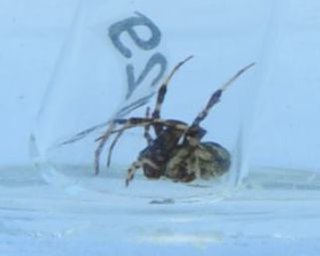
Gea eff is a species of orb-weaver spider. It is found in Papua New Guinea. The arachnologist Herbert Walter Levi formally described the species in 1983. While it was still undescribed, Michael H. Robinson and colleagues reported on its courtship and mating behaviors. Gea eff has the shortest scientific name of any spider species.















